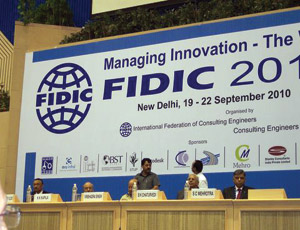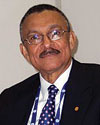The global challenge of managing innovation—and the risks that come with it—galvanized a record crowd of international engineers meeting in New Delhi, India, last month, as they struggle to raise the profession’s image worldwide and tackle the planet’s growing problems.

“In order for us to be innovative, it is time for our profession to be accorded higher standards so we’re not looked at as a commodity to be bought at the lowest price,” Gregs Thomopulos, president of the International Federation of Consulting Engineers (FIDIC), told 750 attendees on Sept. 19 at the group’s annual conference. Thompulos also is chairman of Stanley Consultants, Muscatine, Iowa.
Virbhadra Singh, India’s steel minister, endorsed the concept of innovation as key to the country’s push to complete its ambitious infrastructure program. India plans to increase its five-year investment to $1 trillion from 2012 through 2017, up from $514 billion in the previous period, he said, calling for “innovative design and processes.” Noting the widespread use of FIDIC contract documents in India, he urged the group to help the government improve the country’s engineering and construction capabilities and advance best practices such as sustainable development.
Delegates noted a key need for innovative engineering solutions in addressing climate- change impacts, such as using less-energy-intensive materials and processes. “As climate change threatens existence and economy, we need motivation to do something different,” said Harry Noy, CEO of Dutch engineer Arcadis.

THOMOPULOS
Even as China adapts its approach to environmental stewardship, one delegate noted the challenge. “In our rural areas, local governments’ goals for economic development often clash with the needs of the environment,” he said. Sustainable development is viewed differently in developed and developing countries. “To be honest, local regulations limit us from following certain practices,” said an engineer from Jordan. “Green is still a new concept.”
Even so, speakers noted the plan by the American Society of Civil Engineers (ASCE) to unveil the first iteration of a “sustainable-infrastructure rating system” next month at its annual convention in Las Vegas. “We are on a tight schedule,” said William Wallace, president of Wallace Futures Group, Steamboat Springs, Colo., among those creating the approach.
Even so, speakers noted the plan by three U.S-based engineering groups, the American Society of Civil Engineers (ASCE), the American Council of Engineering Cos. (ACEC) and the American Public Works Association (APWA) to release by next spring the first iteration of a “sustainable-infrastructure rating system.” Some detail of the approach will be presented at the ASCE convention next month in Las Vegas.
“We are on a tight schedule,” said William Wallace, president of Wallace Futures Group, Steamboat Springs, Colo., among those creating the approach. Surrounded by numerous ratings, the groups are determined not to make the system a “me too” product, said Wallace, noting the challenge in crafting the rating components. “There are two levels of performance: Did you do the project right, and did you do the right project?” he said. “There are 75 objectives listed in our first draft. Ours has to be educational and lead down a path [in which] people learn as they go.”
Even with a weak commitment from some international clients to a corruption-free environment coupled with a fear of being put at competitive disadvantage, engineers are embracing business transparency. “Integrity … helps us identify risks—it’s a preventive system and can improve revenue,” said Jorge Diaz Padilla, president of Mexican engineering firm Systec.
The FIDIC conference attracted more than 750 delegates, with the largest delegation of 86 from China.

Post a comment to this article
Report Abusive Comment